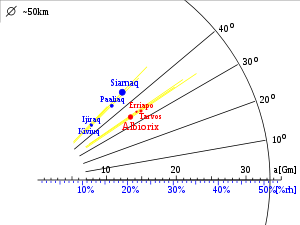.gif)
Siarnaq (moon)
Encyclopedia
Siarnaq or Saturn XXIX, is a prograde
irregular
satellite
of Saturn
. It was discovered by Brett J. Gladman
, et al. in 2000, and given the temporary designation S/2000 S 3.
Named after the giant Siarnaq of Inuit mythology
, it is the largest member of the Inuit group
of irregular satellites.
 Siarnaq is thought to be about 40 kilometres in diameter. It orbits Saturn at an average distance of 17.5 Gm in 895 days.
Siarnaq is thought to be about 40 kilometres in diameter. It orbits Saturn at an average distance of 17.5 Gm in 895 days.
It is light red in color, and the Siarnap (Siarnaqan) spectrum in the infrared
is very similar to the Inuit-group satellites Paaliaq
and Kiviuq
, supporting the thesis of a possible common origin in the break-up of a larger body.
Siarnaq has been found to be in a secular resonance
with Saturn, involving the precession
of its periapsis and that of the planet.1
The studies of these resonances are key to understand the capture mechanism for the irregular satellites and, assuming a common origin of a given dynamical group in the break-up of a single body, to explain today’s dispersion of the orbital elements.
1The ecliptic longitudes of the periapsis
of the satellite and the planet are locked.
Prograde
Prograde can refer to:*Prograde or direct motion, in astronomy, a type of motion of astronomical bodies* Prograde metamorphism, in geology, describes mineral changes in rocks under increasing pressure and/or temperature conditions...
irregular
Irregular satellite
In astronomy, an irregular moon is a natural satellite following a distant, inclined, and often eccentric and retrograde orbit. They are believed to have been captured by their parent planet, unlike regular satellites, which form in situ....
satellite
Natural satellite
A natural satellite or moon is a celestial body that orbits a planet or smaller body, which is called its primary. The two terms are used synonymously for non-artificial satellites of planets, of dwarf planets, and of minor planets....
of Saturn
Saturn
Saturn is the sixth planet from the Sun and the second largest planet in the Solar System, after Jupiter. Saturn is named after the Roman god Saturn, equated to the Greek Cronus , the Babylonian Ninurta and the Hindu Shani. Saturn's astronomical symbol represents the Roman god's sickle.Saturn,...
. It was discovered by Brett J. Gladman
Brett J. Gladman
Brett J. Gladman is a Canadian astronomer and a full professor at the University of British Columbia's Department of Physics and Astronomy in Vancouver, British Columbia. He holds the Canada Research Chair in Planetary Astronomy.-Career:...
, et al. in 2000, and given the temporary designation S/2000 S 3.
Named after the giant Siarnaq of Inuit mythology
Inuit mythology
Inuit mythology has many similarities to the religions of other polar regions. Inuit traditional religious practices could be very briefly summarised as a form of shamanism based on animist principles....
, it is the largest member of the Inuit group
Saturn's Inuit group of satellites
The Inuit group is a dynamical grouping of the prograde irregular satellites Saturn which follow similar orbits. Their semi-major axes range between 11 and 18 Gm, their inclinations between 40° and 50°, and their eccentricities between 0.15 and 0.48....
of irregular satellites.

It is light red in color, and the Siarnap (Siarnaqan) spectrum in the infrared
Infrared
Infrared light is electromagnetic radiation with a wavelength longer than that of visible light, measured from the nominal edge of visible red light at 0.74 micrometres , and extending conventionally to 300 µm...
is very similar to the Inuit-group satellites Paaliaq
Paaliaq (moon)
Paaliaq is a prograde irregular satellite of Saturn. It was discovered by Brett J. Gladman, John J. Kavelaars, Jean-Marc Petit, Hans Scholl, Matthew J. Holman, Brian G. Marsden, Philip D. Nicholson and Joseph A. Burns in early October 2000, and given the temporary designation S/2000 S 2...
and Kiviuq
Kiviuq (moon)
Kiviuq is a prograde irregular satellite of Saturn. It was discovered by Brett J. Gladman in 2000, and given the temporary designation S/2000 S 5. It was named after Kiviuq, a hero of Inuit mythology....
, supporting the thesis of a possible common origin in the break-up of a larger body.
Siarnaq has been found to be in a secular resonance
Secular resonance
A secular resonance is a type of orbital resonance.Secular resonances occur when the precession of two orbits is synchronised . A small body in secular resonance with a much larger one will precess at the same rate as the large body...
with Saturn, involving the precession
Precession
Precession is a change in the orientation of the rotation axis of a rotating body. It can be defined as a change in direction of the rotation axis in which the second Euler angle is constant...
of its periapsis and that of the planet.1
The studies of these resonances are key to understand the capture mechanism for the irregular satellites and, assuming a common origin of a given dynamical group in the break-up of a single body, to explain today’s dispersion of the orbital elements.
1The ecliptic longitudes of the periapsis
Longitude of the periapsis
In astrodynamics, the longitude of the periapsis of an orbiting body is the longitude at which the periapsis would occur if the body's inclination were zero. For motion of a planet around the sun, this position could be called longitude of perihelion...
of the satellite and the planet are locked.

